As my primary language is not English, there are probably some mistakes in my translation.
Remember that the person who speaks here is NOT me, Vincent Celier (@vcelier), but Marc Allaria (@marc-allaria), a French guy.
The fishing file ...
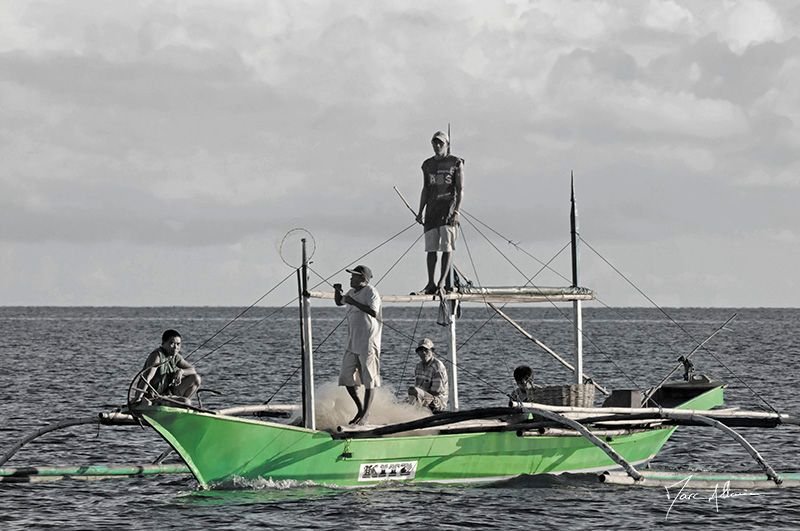
Fishing boat in the Philippines ...
* * * * *
The alchemy between alcohol and the tranquility of a starry night is usually a good catalyst to awaken the seafarer's ability to find solutions for just about every problem on the planet. That night, that was the case for Andy and myself. In less than two hours, we had emptied the oceans of their problems, the planet of his idiots, and the bar of half of its beer kegs. Suffice to say that all the ideas produced were not necessarily of any relevance! And yet, one of these ideas still remains inscribed in my mind for its simplicity and realism. "The problem is the freezer". In five words, my English navigator friend had just solved the problem of overfishing in the world and especially in Asia.
For when you approach Asia from the East of the Philippines after sailing in the rich waters full of fish of Melanesia or Micronesia, where a fishing line rarely stays more than an hour in the water before it provides you the meal of the week, you cannot remain unresponsive to the serenity with which your fishing lure flows into the water without the slightest anguish.
* * * * *
 Destroyed coral debris
Destroyed coral debrisMy meeting with Asian fishing practices began around the island of
Talavera in the east of the country. After practically a month without diving, I had a few ants in the fins and a huge desire to discover the Philippine underwater world. Faithful to my method of pure exploration, I decided on a point on the map without knowing it, I went there by sailboat, and after introducing myself to the village and having met very welcoming people, I could finally put on my scuba and go hunting some underwater shots. Surprise! 10 to 15 cm is the size of the biggest fish I've seen during the first 10 minutes of diving. And then, while resigned to find a "normal" population of fish I retrenched to the search for microorganisms to make some macro shots, there was this totally crazy detonation. With a beating heart , I went to the surface to try to understand what had just happened. Nothing on the horizon except the fisherman I had left on the surface wisely leaning on his fishing line. I had to go back to the village and talk with the locals to understand the origin of the phenomenon. "The dynamite" explained one of the villagers to me. "It's forbidden, but many still use it." Dynamite arrived in Melanesia and Asia with the Second World War. When these areas were demilitarized, tons of ammunition were left behind because they were too cumbersome and expensive to be brought back to Europe and America. The fishermen then discovered a new fishing technique, totally devastating, with the use of explosives left on the spot. When there were no more, they began to manufacture them themselves. Today, despite the ban, this practice and the use of cyanide are very common. They were part of my daily dives.
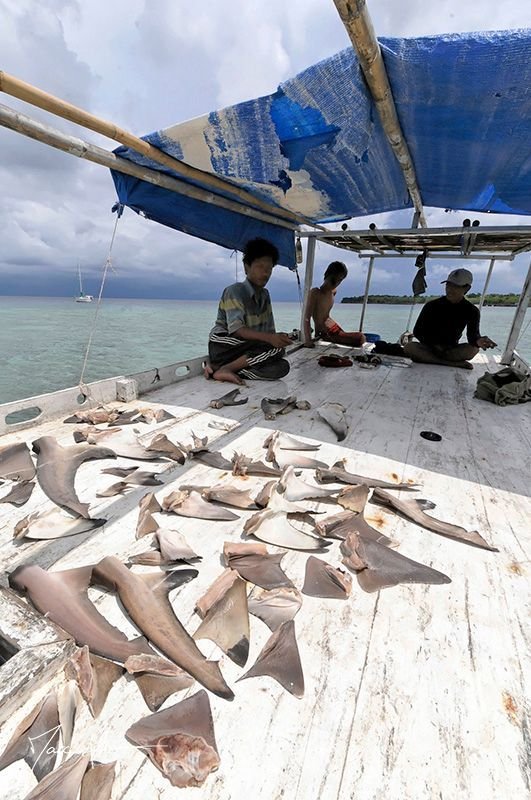 Shark fins
Shark finsAnother surprising observation that I have been able to make during almost all my dives, is the absence of sharks. As much in Melanesia it was impossible to get into the water without being accompanied by a shark, as much here in the Philippines and more generally in Asia, my friends with fins are not there any more. Aileron fishing is of course the first reason. To the point that because of the general absence of sharks in Asian waters, the industrialists of Asia and China now look for fins throughout the Pacific and sometimes even the Indian Ocean. A perfectly woven commercial canvas that brings back fins from all over the planet for industrial use in cosmetics, or for the famous soups made in China.
Cagayan island, an atoll lost in the open Sulu sea in the heart of the Philippines, will remain a stopover that will remind me of many of my stops in Melanesia. Forty-eight hours at sea will be almost necessary for me to go there. Isolation often brings a return to old methods and is one of the factors that leave places a little more virgin than elsewhere. I found the dive profiles of the atolls, made of a first reef wall leading me to -30m along a drop-off, a plateau often sandy, then a second wall carrying me beyond sixty meters. To my dismay, I discovered a first part of the reef composed mainly of hard corals destroyed at 80%. I had to push my descent beyond 60m to discover a landscape made of giant sea fans and soft corals in a state of conservation that I will describe as good. The following days, I was attracted by a construction carried out on the coral reef more than 6 km from the coast. A fisherman nearby explained to me that this construction was the house of the reef guardians. "The poachers come from Negros and Panay," the two closest main islands, "and are fishing with dynamite and cyanide around our atoll. We make them flee when we find them. A difficult struggle that looks very uneven, but has the merit of existing.
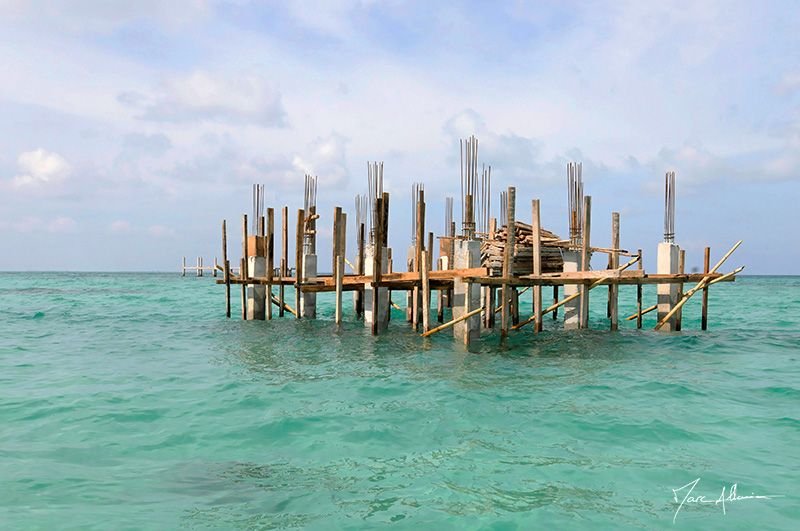
Construction of the guardians' house
* * * * *
 The Bacuit archipelago
The Bacuit archipelagoIn
El Nido, a tourist jewel in
Palawan, in the western Philippines, the diving clubs have settled. The cliffs of the Bacuit archipelago are impressive. Everything lets me hope to find walls covered with corals and underwater landscapes finally rich ... But Jacques, a retired diving instructor, warned me. "Here, it's not the tourists who came because the diving is practiced, but the diving that came because tourism is practiced ...!" In other words, diving only serves to occupy a tourism already present. Before the tourist explosion dating from the "
Koh Lanta" TV show, cyanide and dynamite fishing were common practice. Since then, for tourism, guards have been established in the archipelago, and warn the authorities if they see an illegal fishing. The fishermen have become "Boat men" and everyone is trying to transform the Bacuit island into the image by which it is sold in travel agencies around the world. Underwater Jacques's words are confirmed. The walls are smooth, the coral is bleached by the excessive use of cyanide, and some drop-offs are covered with debris of coral skeletons. The fish are very few. Some islands are being recolonised. Porcelain structures have been implanted and allow the coral to settle "quickly". The area is monitored more than elsewhere, the results are starting to be visible. Satisfactory for a novice tourism, always ridiculous for a person aware of the true splendor of an intact reef.
* * * * *
 Mario
MarioFinally, in Risal, a village in southern Palawan, I meet Mario. "A mouth", as it is affectionately called. 65 years, at least, Mario was born there, has been fishing all his life and he now follows his sons having continued the activity. They have a 8m outrigger canoe and a compressor-hookah system probably of the same generation as my friend Mario! At night they are fishing lobsters, and during the day, the groupers. When I arrived, one of his sons showed me the cooler on the luggage rack of his little motorcycle. "I'm bringing this to the village, the cold truck is coming today ..." Inside there are six red-banded blue groupers, the result of a week of fishing ...
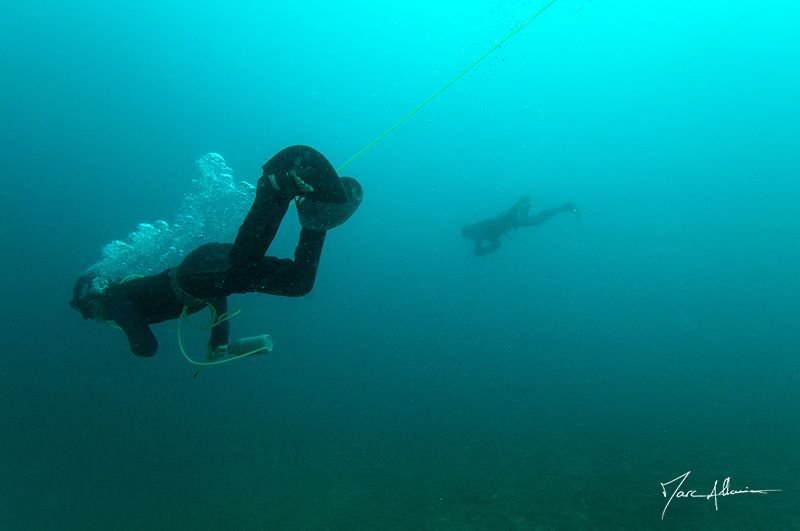 Hookah fishing
Hookah fishingThe next day, I am invited to follow them during their outing. They are equipped with fins made of a fiberglass plate and an elastic tube, long-sleeved clothes as an underwater suit; they take the hookah pipe in their mouth without a mouthpiece, sign themselves, and disappear under water. Many never go back. On the surface, two men follow the bubbles. One releases or takes the pipe on demand, the other manages the canoe that is sometimes drifting strongly with the current to make sure that the hookah pipe does not get caught in the propeller.
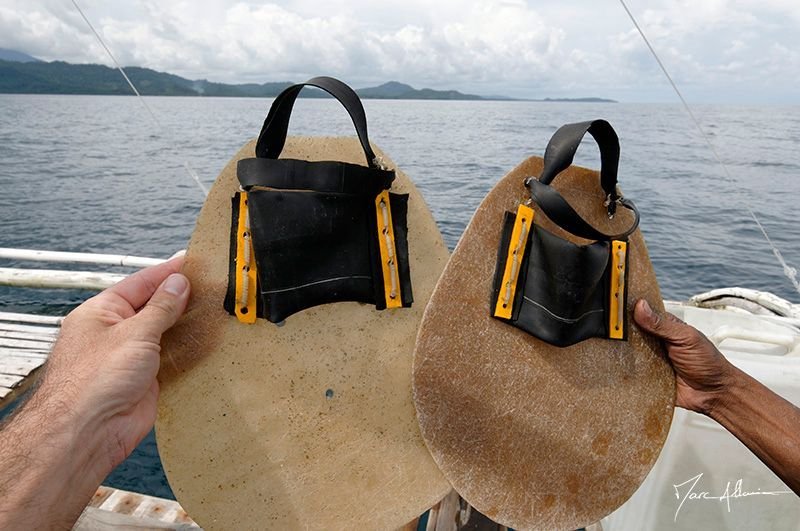 The fins of the divers
The fins of the divers I find my friends under the water. They swim at a crazy speed. I drag myself behind them with the weight of the bi-bottle on my back. A pole equipped with a lasso allows them to catch lobsters and live grouper. Sea hinds (sea cucumbers) are also the target of my fishing friends. They will come out an hour later without having realized the least landing. Today's fishery boils down to five sea beans. It's meager, but it's now their daily life, the sea will no longer provide the resource needed for their needs.
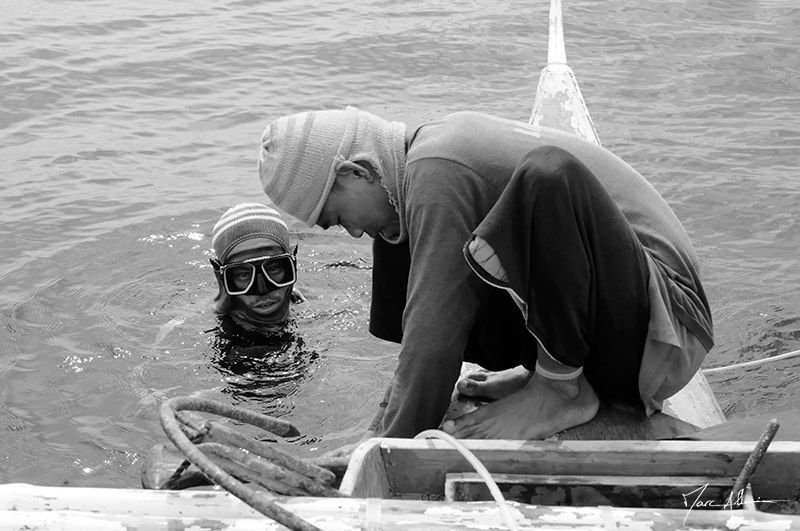
So many messages in this look
* * * * *
It is very difficult and certainly useless to judge these methods. I tell myself that it is slowly being realized and that anyway as soon as the break even point will be deficit, these methods will fade away by themselves. But it is sad to see a population so damaging its environment especially when this same population knows how to show a kindness and a warm welcome. Leaving the Philippines, I do not know yet that I will find this same problem of fishing throughout Asia. Here, the sea is linked to the notion of extreme profitability, by fishing or tourism; excesses are always very quickly reached and know no limit. Andy was right, the problem is the freezer!

DISCOVER THE PHILIPPINES: Funy situations ...! at sea..., by @marc-allaria










